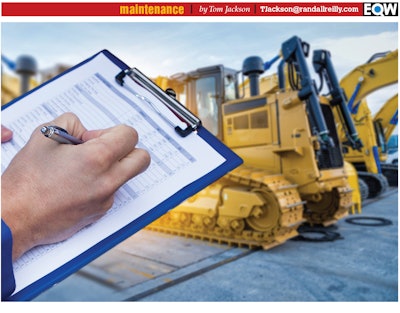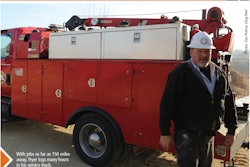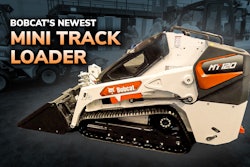
It’s always a good idea to follow best practices in any maintenance program. But what about avoiding worst practices?
We asked two oil company experts to reveal the most common mistakes construction equipment fleet managers make regarding lubes, coolants and greases, and which mistakes cause the most damage. Their answers may surprise you.
Coolants
Although Shell Oil is known as a petroleum-based company, it sells, like most oil companies, engine coolants. Stede Granger, OEM technical services manager for Shell Lubricants, says coolants are often the most commonly mishandled part of a fluid management program.
“Coolants are the least understood fluids on a truck or piece of equipment,” says Granger. “If they don’t do this right, it can have catastrophic impacts and cost a lot of money.”
Some people think all coolants are alike and interchangeable, says Granger. But there are two distinctly different types of coolant – older conventional fully formulated and the newer extended life (or organic acid technology or OAT). These two coolants protect engines from corrosion in different ways, and anytime you mix the two, you dilute or reduce their effectiveness.
The problem arises when someone tops off a radiator with the wrong fluid. Maybe the maintenance manager uses the right coolant. But does the operator, the field service guy, a contracted service provider, a driver or whoever first notices the low coolant level know this?
“The different additives in those different coolant chemistries don’t help each other out,” says Granger. “In mixing the two, you are setting yourself up for possible catastrophic corrosion.” And by catastrophic, Granger means corrosion that eats a hole from the coolant side of a cylinder liner to the oil side. And by the time you see coolant show up in your oil samples, it’s too late. The major damage has been done.
Preventing and solving coolant problems
The solution is to make sure everybody – mechanics, operators, drivers, contract maintenance people – understands the brand and type of coolant used and the dangers of mixing two formulas. This requires training and perhaps an operator care program, and it should be your first line of defense.
The second line of defense is to monitor coolants with test strips made for your coolant type, says Granger. Wet these simple paper strips with coolant in the system. If they turn one color, you’re good to go. A different color means your coolant doesn’t have a high enough percentage of the right additives to prevent corrosion.
Another recommended step is to check the freeze point of the coolant with a hygrometer, or for more accurate results, a refractometer. This will tell you if your coolant is too diluted with water, which also reduces its anti-corrosion properties.
If the coolant is out of spec, it’s not usually necessary to drain and refill the entire system, which on some machines can require dozens of gallons. Coolant vendors offer concentrated coolants to allow customers to bring the coolant levels to the recommended freeze points. A freeze point correction chart will show you how to adjust your coolant so that it is at the proper level. Correction fluids are used to restore additive content to recommended levels. These two procedures enable you to bring your equipment’s coolant back into spec without draining the cooling system.
Your coolant vendor can help you establish these procedures. A good practice is to check the coolant every time you change the oil.
Oil contamination
This is just basic housekeeping, but too often overlooked, says Jami Melani, field engineering/HD technical services manager, Castrol. “Oil contamination is a huge problem and ongoing challenge,” he says.
“A lot of times it starts with the oil delivered in drums or bulk containers,” says Melani. “Drums sit outside in the rain because people think they are sealed tight. But just through everyday heating and cooling those drums will suck moisture right past the gaskets on the bungs.” A desiccant breather on your bulk lube oil tanks will go a long way toward preventing moisture contamination.
Moving from bulk storage to the machine also introduces opportunities for contamination. “We’ve found some shops use a lot of dirty, open-top containers,” says Melani. And sometimes technicians will use a spare container that had been used to handle other products such as coolant, transmission or hydraulic fluid. Even small amounts of these other fluids will compromise the effectiveness of your lube oil and cause erroneous readings in a used-oil analysis report.
“If you keep lubricants clean, cool and dry, you’re going to get better life out of your product and your equipment,” says Melani. And keeping your lubricants cool means making sure your engines don’t exceed the recommended operating temperatures. “There is a basic rule of all lube oils,” says Melani. “As oil temperature increases, the oxidative life of the oil decreases.”
Lube oil oxidation today is a big deal for engine oils in the heavy equipment world. “Engines are running hotter all the time,” says Melani. It’s one of the reasons the oil industry developed a new lube oil standard, API CK-4, which requires heavy-duty diesel engine oils to better resist oxidative degradation.
Getting grease right
While greasing a machine isn’t the most technical task, doing it at the right intervals and using the right product are important, says Granger. “More often than not, putting less grease in more frequently is better than putting more grease in less frequently,” he says.
When you pump a lot of grease through a joint, most of it is wasted, says Granger. “The amount of grease that is doing the lubrication is actually very small. Sometimes it is no more than the size of a pea. The mechanical motion of the joint tends to squeeze that grease out over time. Until it gets regreased, it’s going to have no lubricant in the joint. So overextending grease intervals is not a good idea.”
This is why central grease systems work so well. They give a tiny bit of grease frequently. Grease can also get contaminated, and by greasing more frequently, you purge the contaminated grease, says Granger.
Moly greases, those that contain a small amount of molybdenum, are better at sticking in a joint, says Granger. “They stay put longer while the other stuff squeezes out, but after a period of time, that goes away too.”
Granger also recommends finding the OEM’s specifications for all greasing applications and sticking to them. For example, a heavy-duty grease with tackifiers works better on joints under a heavy load. But those greases aren’t good for things like lubricating U-joints on drive shafts, with their small needle bearings and passageways.
Move from reactive to proactive
These days it seems everybody is trying to do more with less, says Melani. In used-oil analysis, they’re not taking time to look at the results. They don’t read it. They put it in a drawer and forget about it, not understanding and not responding to the information given to them.
When fleet managers see a red flag on an oil analysis report, they have to pull the machine from the field and find out what’s going on. But such regressive or reactive maintenance, says Melani, is expensive in terms of downtime and damage to a machine.
“Usually there is a trend line,” says Melani. “Most of the time when you get a sample that shows something terribly wrong, you probably had a previous sample that gave you a hint that something was going wrong.” That gives you a chance to be proactive, schedule workarounds to fix problems before they disrupt operations or become catastrophic failures.
The next step up is getting to the point where as a technician or fleet manager your ability to read and interpret a used-oil analysis becomes as much an art as a science, says Melani. “There are so many factors. You have to look at the environment, the application, the metallurgy of the equipment, the product, the severity of the application, all kinds of factors. But there is a great payback.”
The end goal is to move toward a world-class maintenance program and key to that is institutional learning. “From the top to the bottom of the organization, they have to be interested in learning and want to know how to get better,” Melani says.
Do that, and the benefits and savings can be astronomical. “There is a lesser or some difference between different products,” Melani says, “but there is a huge difference between the practices of a regressive maintenance program and one that is proactive.”













